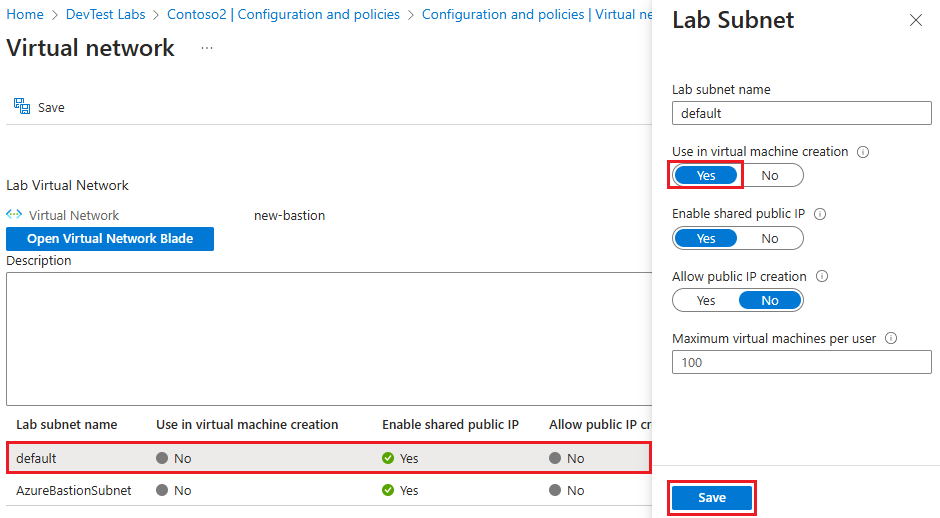Note
Access to this page requires authorization. You can try signing in or changing directories.
Access to this page requires authorization. You can try changing directories.
Azure DevTest Labs integrates with Azure Bastion to allow connecting to lab virtual machines (VMs) through a browser. When a lab owner enables browser access to lab VMs through Bastion, lab users can connect to their VMs through their browsers without needing any other client, agent, or software.
Azure Bastion provides secure and seamless remote desktop protocol (RDP) and secure shell (SSH) connectivity over transport layer security (TLS), directly from the Azure portal. Lab VMs don't need public IP addresses.
This article covers two ways to enable Azure Bastion browser connectivity to DevTest Labs VMs:
- Create a new Azure Bastion-enabled virtual network for your lab
- Deploy Azure Bastion in your existing lab virtual network
Prerequisites
- To enable and configure Azure Bastion for a lab, you need Owner or Contributor role in the lab.
- To connect to an Azure Bastion-enabled lab virtual machine (VM) through a browser, you need ownership access to the VM and at least DevTest Labs User role in the lab.
For more information about DevTest Labs user roles and access, see Add and configure lab users.
Option 1: Create a new Azure Bastion-enabled virtual network
You can create a new virtual network for your lab with an Azure Bastion subnet and another subnet in it. An Azure Bastion subnet allows only Bastion resources in it, so you use the other subnet for creating lab VMs.
In the Azure portal, search for and select virtual networks.
Select Create at the top of the Virtual networks page.
On the Create virtual network page, enter a Name for the new virtual network, and select the same Subscription, Resource group, and Region as your lab.
Select Next or the Security tab.
On the Security page, under Azure Bastion, select the Enable Azure Bastion checkbox. Accept or configure the values in the Azure Bastion host name and Azure Bastion public IP address fields.

Select Next or the IP Addresses tab.
On the IP Addresses page, ensure there are two subnets named default and AzureBastionSubnet, and configure IP address ranges if necessary.

Select Review + create, and when validation passes, select Create.
Once the new virtual network is created, go to its page, select Subnets in the left navigation, and confirm that there are two subnets, default and AzureBastionSubnet.

Connect your lab to the new virtual network
Follow these instructions to connect your lab to the new Azure Bastion-enabled virtual network.
From your lab Overview page, select Configuration and policies in the left navigation.
On the Configuration and policies page, in the left navigation under External resources, select Virtual networks.
On the Virtual networks page, select Add.
On the Virtual network page, select Select virtual network.
On the Choose virtual network page, select the Azure Bastion-enabled virtual network you created.
On the Virtual network page, select Save.
On the Virtual networks page, remove any previous virtual network from the lab. Select ... next to that virtual network, select Delete, and then select Yes.

Enable VM creation in the default subnet
Follow these instructions to enable VM creation in the default subnet of the new virtual network.
On the Virtual networks page, select the Azure Bastion-enabled virtual network.
On the Virtual network page, make sure that both the AzureBastionSubnet subnet and the default subnet appear, and select the default subnet.
On the Lab Subnet pane, select Yes under Use in virtual machine creation, and then select Save. You can now create VMs in the default subnet of your lab virtual network.

Option 2: Deploy Azure Bastion in the existing lab virtual network
You can enable browser connections to existing lab VMs by creating a new Azure Bastion subnet in your lab's existing virtual network.
On your lab Overview page, select Configuration and policies from the left navigation.
On the Configuration and policies page, select Virtual networks under Settings in the left navigation.
Select your lab's existing virtual network, and on the virtual network's page, select Open Virtual Network Blade.
On the virtual network's page, select Bastion under Settings in the left navigation.
On the Bastion page, if necessary, add a new address range that's within the virtual network's address space, but doesn't overlap with the existing lab subnet.
Select Deploy Bastion.

Enable connections through Azure Bastion
Once you deploy Azure Bastion in a new or existing lab virtual network, enable browser connections for the lab.
On the lab Overview page, select Configuration and policies, and then select Connect via Bastion under Settings in the left navigation.
On the Connect via Bastion page, set Connect via Bastion to On, and then select Save.

Connect to lab VMs through Azure Bastion
To connect to a Bastion-enabled lab VM:
- On the lab Overview page, select the lab VM from My virtual machines.
- At the top of the VM's page, select Connect > Connect via Bastion.
- In the Browser connect pane, enter your VM's username and password, and select Connect.
For more information, see Connect to lab VMs in a browser via Azure Bastion.